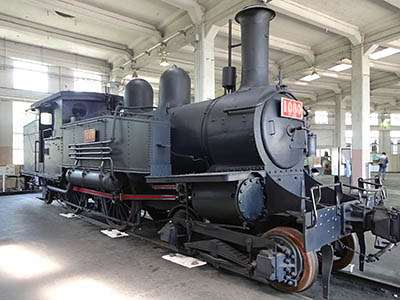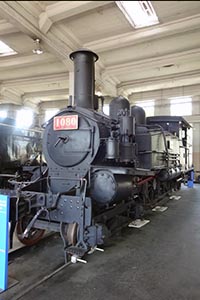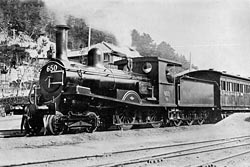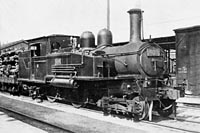|
1080
Static Exhibit |
1901 - 1979 (JGR 1901-1938) |

|
The original No.1080, class 1070 4-4-2 Tank-Engine was an imported 4-4-0 Tender-Engine used
as the main engine on the Tokaido arterious line.
All of the 4-4-0 (American type) tender engine series were completed during 1908,
there were 135 engines in four classes, and were called the Series-6200.
Later, class "AN" was renamed to class "D9" when class names were revised during 1898. "D" means a four driver wheeled tender engine. During 1900, JGR ordered 57 more class D9s from the Neilson Co, separated between Neilson company and the Dubs and Company. They were named No.600-656. A total of 75 class D9's saw service from Shimbashi - Kozu and Numazu - Baba (currently Otsu) as an express train, and as a local train between Shimbashi and Yokohama on the Tokaido line. And again during 1908, 60 more class D9s were added, 36 were from the German company Hanover, and 24 were from the American Locomotive Co., and the total class D9 engines grew to 135. During October 1909, there was a class name revision, and class D9 was divided into four classes by builders as follows ........
Around 1911, they were deployed mainly in the Osaka and Nagoya areas and saw service on the Tokaido line. However, traffic volume rapidly grew during WW1, and also a more modern engine made its appearance, the Series-6200 gradually became surplus from around 1914. Consequently, a part of the Series-6200 was transferred to the Sanin, Hokuriku and Chuo sub main lines. 15 of the class 6200, and one of the class 6270, a total of 16 were reconstructed to " Superheated Boiler " type engines during 1924, and were named class 6250 No.6250-6265. They were used up to the 1950s. During 1923, 10 class 6200 (No.6237-6239,6242 and 6244-6249) were sold to the Tobu Railway Co. They saw freight service on the Tobu Railway until 1963. Between 1924 and 1928, all of the 135 Series-6200, with the exception of 5 in the class 6300, 10 were moved out to the Tobu Railway and 16 were remodeled to the class 6250, for a total of 104 which were reconstructed to 4-4-2 tank engines due to their transfer to branch lines and yard works. Not remodeled were five in the class 6300 which were retired and scrapped. Reconstruction chart as follows ......
However, around 1937, Japan went on a war footing, so, older Tank Engines were used by private railway companies due to the unavailability of new engines. As a result, 19 class 1000, 1070 and 1150 were transferred (or sold) to private railway companies. Remainng JNR engines were used until around 1952. Of those transferred to private railways, most were used up to 1961 except No.1080. |
|
Preserved engine No.1080
Class 1070 No.1080 was manufactured at the Dubs Co. manufactured No. 4166 during 1901 as a 4-4-0 Tender Engine, and was named No.651. Since then, she was active on the Tokaido main line. During October 1909, she was renamed to class 6270, No.6289. During February 1926, 6289 was remodeled to 4-4-2 Tank Engine Class 1070 No.1080 at the JGR workshop. After remodeling, 1080 was active at Nagoya area's South-Etsumi, Takayama lines etc up to 1939 ...... During October 1940, she was retired at the Mino-Ota depot, and was transferred to the Nittetsu Kogyo Co. Akatani mining firm in Niigata, and was used on the Akatani mine line. Later, she was transferred to the same company's Kuzuu mining firm in Tochigi because of the Akatani mine closing. She saw service on the Hanezuru mine line in Kuzuu mine until 1969. During 1969, Hanezuru line was dieselized, but 1080 was left as a spare engine. And she was open fired in the fireplace and ran in the yard, once in a while, up to June 1979. However, after it's retirement, 1080 was accepted as worthwhile, as the Meiji era's (1868-1912) typical main line engine, and the company kept that engine at its own Hanezuru shed. Afterward, the 1080's preservation plan was considered several times by the local city, but that never really materialized. In time, Hanezuru line was closed on the 26th of November 1991, therefore, 1080 was not able to move to any other place easily. During July 2009, 1080 was donated from the Nittetsu Co to JR-West, and exhibition at the Umekoji Museum was decided. She was taken out by truck and was moved to Kyoto, and was restored to new condition. Finally 1080 was shown to the public at Umekoji Museum from the 14th of September 2009. |

| 
|




